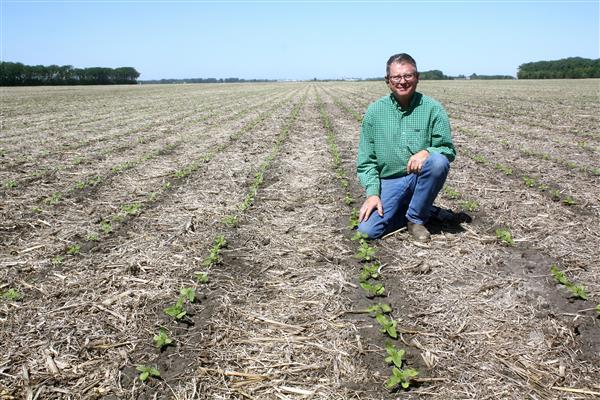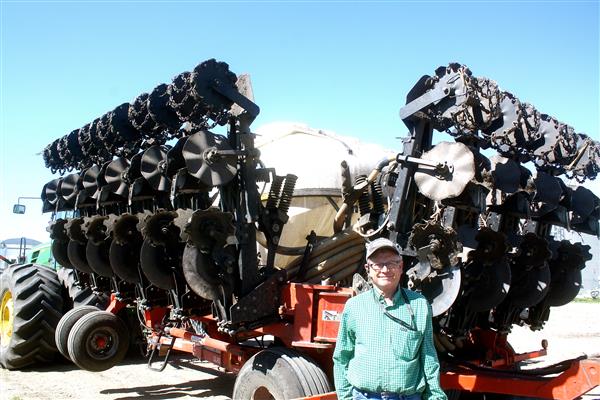Article Archives
Strip-Till ’Flowers Shine During 2020
Friday, January 1, 2021
filed under: Planting Systems
 Bruce Speich
Bruce Speich
Like many others who have employed strip till in their crop production systems, the Speichs — father Bruce (a National Sunflower Association board member) and sons Kyle and Tyler — were looking to slash soil erosion when they initiated the practice. That has indeed been the result; but they’ve likewise garnered additional benefits that, when combined with erosion management, make them firm believers in strip tillage on their farm.
Among those pluses are fertilizer placement and use rates. The majority of their sunflower fertilizer goes on with the strip-till pass, followed by starter with the planter. Bruce estimates they’ve been able to save at least 25% on fertility rates, versus broadcasting under their previous conventional tillage regimen.
Speed of sunflower emergence — compared to their no-till acres — is another significant plus. “That strip definitely warms up quicker, and we end up with faster emergence and a nice consistent plant stand,” Bruce affirms.
The Speichs, who farm in southeastern North Dakota’s Sargent County, first experimented with strip-tilled corn a decade ago on a sandy quarter section. “It was so windy that spring that [conventional corn] would have just blown out,” Bruce recalls. “We had to do something for erosion control, to minimize soil loss on those highly erodible soils.”
Since then, they’ve expanded their strip-till acreage to include some heavier ground and sunflower as well as corn. On those acres, they prefer to strip till in the fall and let the ground settle over winter, though that’s been a challenge in some years — 2019 being a prime example — due to very wet harvest and post-harvest conditions.
 They weren’t satisfied with the performance of their initial strip-till unit, so later purchased a 16-row Krause Gladiator that they’ve used ever since. They purchased a new Krause unit for 2021.
They weren’t satisfied with the performance of their initial strip-till unit, so later purchased a 16-row Krause Gladiator that they’ve used ever since. They purchased a new Krause unit for 2021.
The Speichs had about 300 acres of sunflower in 2020 — half in a strip-tilled field and the other half under no-till. The no-till field was in alfalfa as of 2019. “It’s really heavy ground that’s tough to dry out,” Bruce says. “So we sprayed out the alfalfa and planted rye last fall. But it was so wet that the rye crop was horrible. That’s what we planted into [in 2020].”
This past spring, however, turned out to be very dry in their area. “We always expect to get a good shot of rain, but this really was an unusual spring [in terms of] lack of precipitation,” he continues. In referrence to the no-till field, he adds, “I should have had more pressure on the closing wheels; where the trenches didn’t close up tight, it dried out” — and that was reflected in poorer seed-to-soil contact and the field’s emergence and plant stand.
All of their sunflower acres are confections, going in at a seeding rate of 18,000. The Speich 2020 ’flowers under strip till — planted on old soybean ground — achieved quicker emergence and a significantly better plant stand, compared to the no-till field a couple miles away. “They were up and out of the ground in no time,” Speich recounts. “It was about as perfect, as even a plant stand as I’ve ever seen.”
A burndown treatment preceding the fall 2019 strip-till pass, coupled with a pre-emergence application of Authority® Supreme, resulted in excellent weed control in that sunflower field. An insecticide treatment for seed weevil and banded sunflower moth was aerially applied in a tank mix with the fungicide Priaxor (for rust control). The last in-season operation prior to harvest was a desiccation pass with gramoxone. The field had some Sclerotinia head rot, but it was quite limited.
The Speichs’ 2020 strip-tilled confection field ended up netting around 1,900 lbs/ac with good test weight and quality.
Their 2021 sunflower acreage plans were still under consideration as of December, with available confection contract prices being the key component. Whatever the number of sunflower acres they do raise, however, strip till will be part of the equation, Bruce says. “It’s been a good system for us,” he concludes. “With any type of tillage process or no-till, it’s as much a mindset as anything. You adopt what you want to accomplish. And the main reason for us was wind erosion control, soil conservation.”
— Don Lilleboe